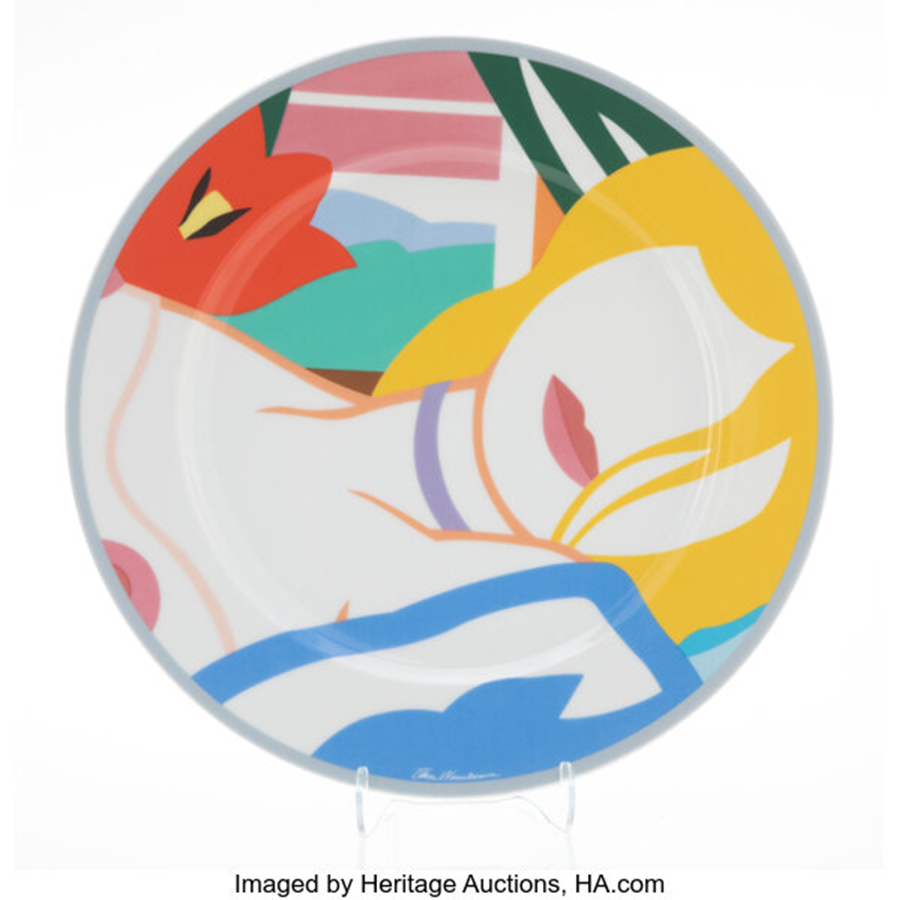THREE ART EXPERTS ON THE TIPS AND TRICKS EVERY EMERGING COLLECTOR NEEDS TO KNOW
By Barbara Tunick
Starting an art collection can be an exhilarating and deeply profound experience. It can also be daunting and confusing. Just as no two pieces of art are the same, neither are collectors, their collections nor the inspiration and motivation behind them. To help you curate a worry-free collection with knowledge, confidence and a little bit of curiosity, we asked three art experts to give us their top collecting tips and most candid advice.
Damien Hirst ‘Claridges,’ 2018. Diasec-mounted giclée print on aluminum panel. Ed. 68/100. Estimate: $6,000-$8,000. Offered in Heritage’s April 18 Prints & Multiples Signature® Auction.
Know Your Why
Before you buy your first painting, sculpture, photograph or print, ask yourself the most fundamental question: Why do you want to start a collection? Are you buying art as an investment, to decorate your home or because you aspire to become a serious collector with significant pieces of historical and cultural value? Understanding your motivation is essential in every step of the process, from establishing a budget and selecting individual works of art to storing and displaying your collection.
“I think it’s important to view art collecting as a way of elevating your life experience, rather than just as an investment strategy,” says Ariana Hartsock, Heritage Auctions’ Director of Fine Art, Dallas. “Buying works of art is about participating in culture. Being able to own or be the temporary steward of a tangible moment in human history is a very powerful experience. Collecting art in a serious way is about continual learning, sharpening your skills as a connoisseur and the persistent pursuit of quality.”
Holly Sherratt, Director of Modern & Contemporary Art at Heritage, also advises against buying art strictly for investment, because not all artwork appreciates over time. However, if you are looking for the best return on investment, Sherratt’s advice is to buy at auction. “Our estimates are data-driven and based on past auction results,” she says. “People can access past sold prices on HA.com or through an online auction database. If you buy a work at auction, you are paying the fair market value, not a high retail price, and since the artist has an established secondary market, you can resell your work at auction.”
Yoshitomo Nara ‘Cosmic Girl (Eyes Open, Eyes Shut),’ diptych, 2008. Offset lithographs in colors on smooth wove paper. Edition of 500. Estimate: $5,000-$7,000. Offered in Heritage’s April 18 Prints & Multiples Signature® Auction.
Set a Budget
“If you are buying art simply to fill up space on your walls, setting a strict budget and sticking to it is easy,” Hartsock says. “But if you want to begin collecting more significant works of art that will hold value over time, it’s imperative to set a budget for the specific piece you’ve decided to acquire. Falling in love with a work of art can be as emotional as falling in love with a person. It’s easy to get caught up in the thrill of the pursuit and to throw your budget out the window. Setting your absolute highest spending limit and sticking to it, especially when buying at auction, takes discipline, self-restraint and practice.”
Sherratt offers similar advice: “Buy what you love but spend what you can afford.” If you need guidance setting a budget, art advisors can help. Organizations such as the International Society of Appraisers (ISA) and the American Society of Appraisers (ASA) maintain databases of licensed appraisers. “Auction experts also act as art advisors,” Sherratt says. “We welcome questions about buying and selling art at our organization or elsewhere.”
Sometimes, however, you can’t help getting carried away and spending more than you intended on a work of art. It can even happen to the most experienced, knowledgeable professionals – and it doesn’t necessarily end in regret. Hartsock recalls a piece she bought at Heritage that ended up costing more than she had originally planned: a small painting by the 19th-century English artist Sir Alfred East, who created a well-known series of oils on panels after visiting Japan for the first time.
“The piece I bought depicts springtime in Japan, with beautiful pink blossoms and little children dressed in kimonos in front of a traditional Japanese house,” she says. “It’s a little treasure hanging on a perfect spot on my wall in a big, gorgeous frame. Every time I walk by it, I get a little rush. It perfectly exemplifies what I tell my clients about figuring out how much a painting or other work of art is worth. You always have to factor in the experience of being able to live with it and enjoy it. That’s why it’s so important to buy with your heart.”
Joan Miro ‘Untitled,’ from ‘Oda à Joan Miró,’ 1973. Lithograph in colors on Guarro paper. H.C. (aside from an edition of 75). Estimate: $5,000-$7,000. Offered in Heritage’s April 18 Prints & Multiples Signature® Auction.
Think Beyond the Canvas
New art buyers might feel discouraged by the hefty price tags associated with original works of art, but with limited-edition prints, even on a tight budget, collectors can own iconic works of art by well-known artists. “Collectors can acquire prints for a fraction of the price of a painting or a sculpture,” Sherratt says. “Fine art prints, which artists create on silkscreen, copper plate and other print matrix, are considered original art, not posters made by photomechanical means. They are not copies of other paintings, but unique art pieces printed in small editions.” Her advice: Look for prints that are signed and numbered in pencil – the fewer prints created, the more valuable the artwork.
Walter A. Ramirez, Consignment Director of Urban & Contemporary Art at Heritage, says buying limited-edition prints also makes collecting art more accessible to younger collectors. “As long as you’re buying quality prints, you can always start collecting work on paper and eventually work your way to canvas,” he says.
But if you truly have your heart set on collecting original paintings and sculptures, Sherratt suggests buying oversize works at auction. “Galleries price artworks according to size, and extra-large pieces are expensive,” she says. “The reverse might be true at auction since fewer people bid on extra-large works due to space limitations.”
Tom Wesselmann ‘Blonde Vivienne (plate),’ 1985. Glazed porcelain plate transfer-printed in colors. Estimate: $800-$1,200. Offered in Heritage’s May 17 Prints & Multiples Showcase Auction.
Do Your Research
“The only way to know what to collect is to expose yourself to as much art as possible,” Sherratt says. Museums, gallery exhibitions, auction previews and art fairs are great places to start. You could also take it a step further and schedule a visit to a printmaking workshop or meet the artists at their studios. Immersing yourself in art will help you figure out what kind of works you’re drawn to and which artists you like so you can begin to cultivate your style and hone your taste. “Once you determine what interests you,” Hartsock adds, “do your research and soak up as much information as possible.”
Browsing for art online is another way to discover and connect with artists and galleries. Ramirez is a fan of Instagram and Artsy.net, two well-established online platforms that give collectors direct access to artists. “I come across new artists all the time on Instagram because once you ‘like’ a certain artist or gallery, the algorithm shows you similar artists and places,” he says. “Online sources are great alternatives to visiting galleries and art fairs in person, especially for contemporary art. They’re also great places to buy art directly from the artist and gallery.”
But no matter where you’re shopping for art, Sherratt says there’s one thing you should always remember to do: “Make sure you ask a lot of questions about the provenance, or history, of the piece,” she says. “Has it been exhibited? Is it listed in the artist’s catalog?” She also warns new collectors to be wary of fake certificates of authenticity. While some are legitimate, created by the artist, their foundation or an art scholar, realistic-looking fakes are widely available. Your best bet? Consult an auction catalog to look up the authenticator’s name for any given artist.
If you still have questions about a specific piece – the condition of the work, how much it might cost to restore it if needed, how significant it is in the artist’s oeuvre and how it compares to the artist’s other works, for example – seek advice from a professional. “As auction specialists, we’re more than happy to help you build the best collection you can,” Hartsock says. “And we’ll always give our honest opinions.”
For inquiries, contact Ariana Hartsock at ArianaH@HA.com or 214.409.1283; Walter Ramirez at WalterR@HA.com or 212.486.3521; and Holly Sherratt at HollyS@HA.com or 415.548.5921.
BARBARA TUNICK is a contributor to Intelligent Collector.





